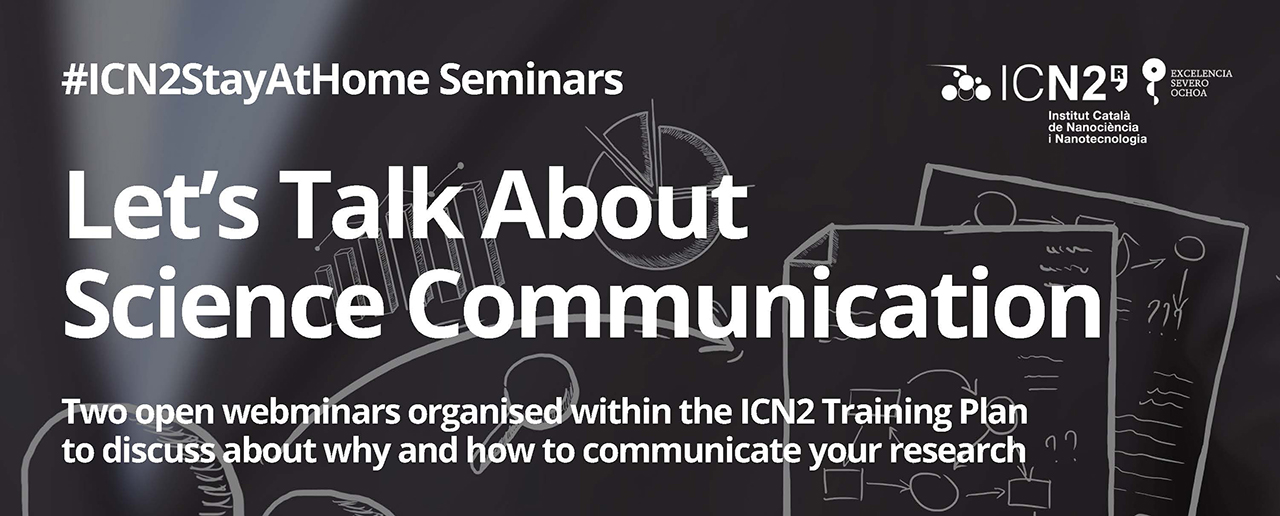On April 20-21, the ICN2 held two webminars on why and how scientific research and its results should be shared both with peers and society at large. Science communicators Dr. Brynley Pearlstone and Sarah Cosgriff and science journalist Dr Michele Catanzaro provided their perspective and advice to more than one hundred attendees, mainly researchers. The event was coordinated by the ICN2 Human Resources Department in the context of the ICN2 Training Plan and organized by Dr Justin Sperling, of the ICN2 Advanced Medical Electronics group, and Àlex Argemí, Head of the ICN2 Marketing and Communication Department.

In the framework of its training activities for researchers supported by the Severo Ochoa strategic plan and the #StayAtHome webminar series, the ICN2 organized two open discussions, held on April 20-21, dedicated to Science Communication. Experienced communicators were invited to provide their insight about how various media can be used to reach out to different audiences and disseminate science and research results. The reflection started from clarifying why popularizing science and bringing research closer to people is important both for society and for scientists. Then it continued with analyzing how it can be done effectively, depending on the kind of public that we may want to address, the channel we choose and the objectives that we are pursuing.
The first part of the two-day “Let’s talk about Science Communication” webminar, which took place on April 20, focused on how scientists can share research with peers and society through social networks and outreach activities. After an introduction by Dr Justin Sperling, senior post-doctoral researcher in the ICN2 Advanced Electronic Materials and Devices group, the topic was examined in a joint talk by award-winning astrophysicist and freelance science communicator Dr Brynley Pearlstone and by science communicator Sarah Cosgriff. They discussed about defining a target audience, picking the right channel to reach that specific public as well as the language and form to best appeal to it. They stressed also the importance of inclusiveness, which can imply tailoring different messages or using specific media to address our target audience.
Pearlstone has extensive experience in creating content for his SciCurious podcast series and in organizing science events, with a focus on highlighting LGBTQ+ people in STEM and reaching the queer community. Cosgriff is employed by the UK Institute of Physics and works with secondary schools to address the uptake of physics by girls. She is also a freelance science communicator and, as such, she presents shows, delivers training and manages projects.
The second part of the webminar, held on April 21, covered the relationship between science and “classic” media, in particular magazines and online newspapers. Freelance journalist and physicist Dr Michele Catanzaro brought his expertise in writing scientific news for different publics and various outlets, spanning El Periódico, Le Scienze(the Italian version of Scientific American) and Nature. He provided the viewpoint of journalists seeking interesting stories and provided advice to scientists on how to reach out to media, how to interact with journalists and to pitch their research to them. His talk was introduced by Àlex Argemí, Head of the ICN2 Marketing and Communication Department, who also highlighted the role played by in-house communication officers of research institutions, who are often the first contact point between scientists and journalists.
The event was highly participated on both days, with over 100 people connected from start to finish and many questions asked to the panelists. Many of these were answered to during the webminars, while all the speakers gave their availability for continuing the conversation off-line with whoever was interested. The recording of the two parts of the webminar are available online on the ICN2 YouTube channel.

